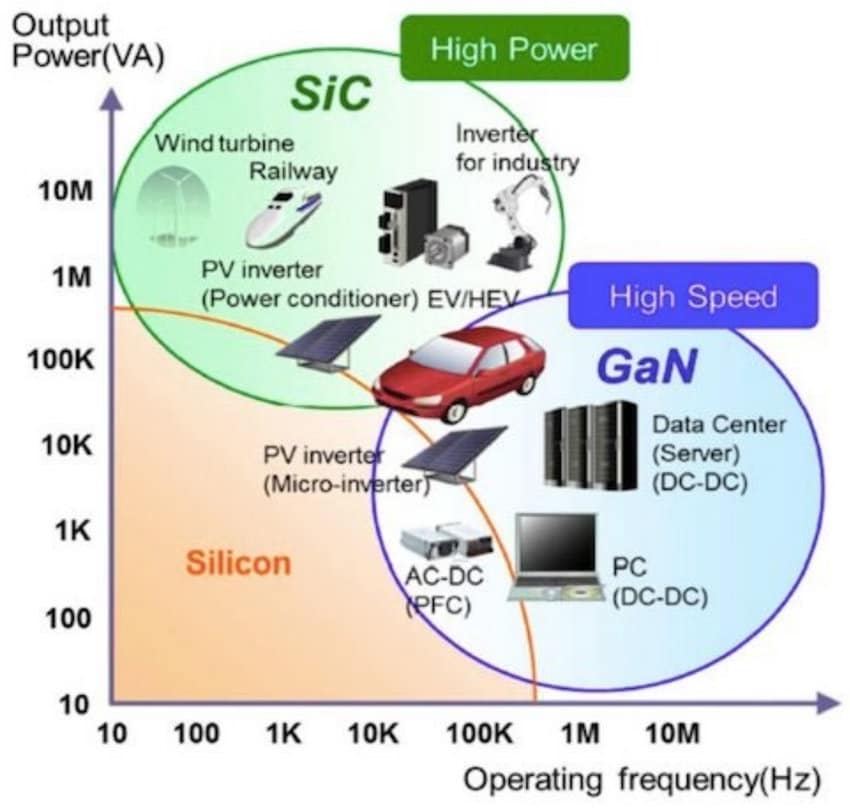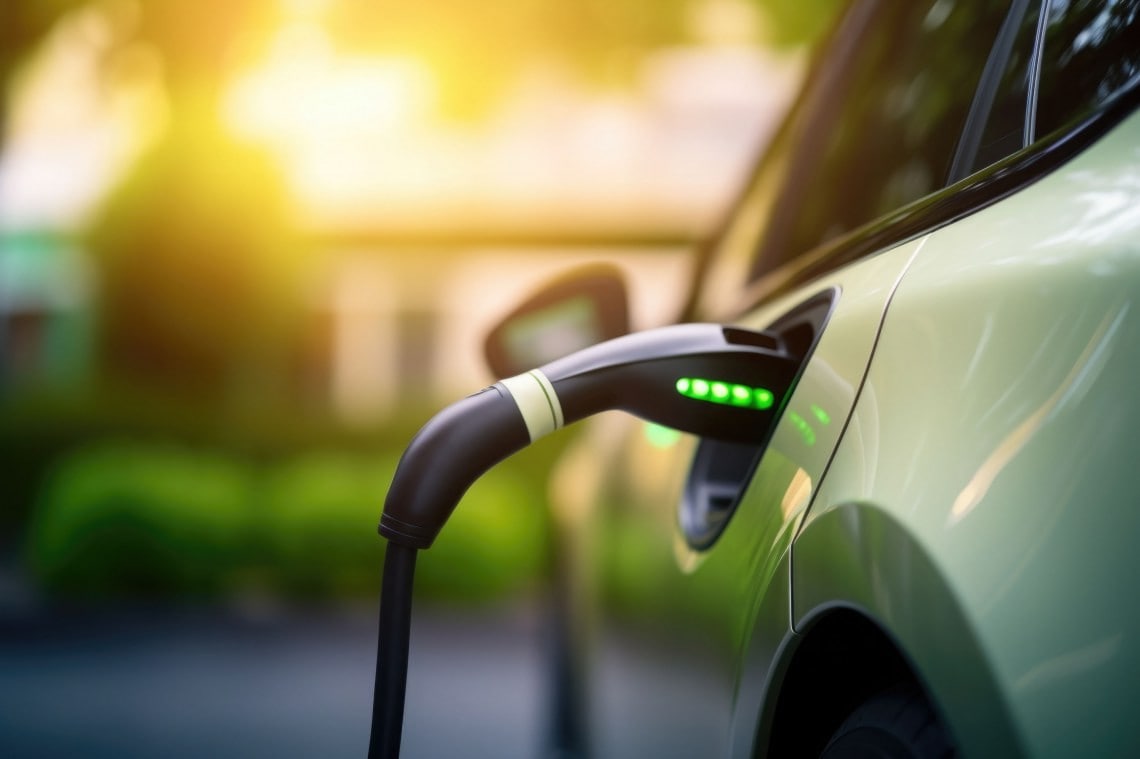SiC and EV Charging—A Catalyst for Innovation
Silicon Carbide (SiC) is a key enabling technology in increasing the power of Electric Vehicle (EV) chargers to recharge EV batteries faster.
Silicon Carbide Powers Next-Generation EV Chargers
For more than half a century, silicon has been the default semiconductor for logic, memory and other devices, including power Integrated Circuits (ICs). New high-power applications are testing the performance limits of silicon power ICs, however, compelling the electronics industry to find a replacement semiconductor for power ICs.
Silicon Carbide (SiC) has already demonstrated itself to be a superior alternative to silicon for many of these high-power applications, among them prominently electric vehicle (EV) motors and EV chargers.
The desire to increase the power of EV chargers is tied to the desire to recharge EV batteries faster. SiC is a key enabling technology.
Level 1 and Level 2 chargers are still the most commonly available chargers for EVs. Level 1 chargers work on 120V circuits, the standard for household wiring in the U.S. They are relatively low power (figure 1), however, and fully replenishing an EV battery with a Level 1 charger typically requires keeping the vehicle plugged in overnight.
Level 2 chargers usually require 240V circuits and are higher power. They are more common in parking lots and retail charging stations, though some homeowners opt to upgrade their electrical systems to 240V to support faster Level 2 chargers.
Level 2 charging rates vary among EV makes and models, and from one charger to the next. For example, different Level 2 chargers have different power levels and can be rated at 32 amps, 40A, 50A and now 80A. Taking all the variables into account, it can take a Level 2 charger anywhere from four hours to 10 hours to charge a fully depleted EV battery to 80 percent capacity, according to the U.S. Department of Transportation (DOT).
EV makers and EV owners would like to reduce charging times to an hour or so and would rejoice if charge times could be whittled down to as little as 12 to 15 minutes. The industry is taking two paths toward faster charging.
One is to improve Level 2 chargers. Level 2 chargers deliver AC power to the DC batteries in EVs (as do Level 1 chargers). Inverters are essential in converting AC power to DC (or vice versa). Inverters have traditionally been built using silicon MOSFETs and IGBTs (insulated-gate bipolar transistors). The industry is replacing the silicon devices in Level 2 chargers with SiC devices in part to accelerate charging times.
Level 2 chargers can be improved, but not enough to lower charging times to minutes. So, the other path is the creation of Level 3 chargers. Level 3 chargers perform DC to DC charging. Level 3 chargers are often referred to as fast chargers, and they are. The DOT says they can recharge an EV battery to 80 percent in as little as 30 to 40 minutes.
Meanwhile, the expectations about how EVs will be used are evolving. Why shouldn’t we be able to tap that stored energy in emergencies? Why wait for emergencies—why not use EV batteries whenever it’s convenient to do so?
The potential uses have added to the electronic industry’s alphabet soup. There is vehicle to vehicle (V2V) charging, vehicle to home (V2H) charging, vehicle to grid (V2G) charging and vehicle to whatever else (V2X) charging.
Automotive OEMs including Ford and GM, for example, are among the advocates for bidirectional charging.
Given silicon’s limitations, it is more efficient and cost-effective to implement faster charging and bidirectionality with SiC power devices (figure 2). The reasons are that SiC offers higher breakdown voltage, faster switching speeds, lower on-resistance, higher operating temperatures and improved ruggedness.
As a practical matter, swapping in a SiC device for its silicon counterpart provides several benefits:
- Extremely low switching losses improve system efficiency.
- High power density reduces size and weight.
- SiC is three times more thermally conductive than silicon.
- Heat sink requirements are reduced, consequently power subsystems can have a smaller footprint and weigh less.
- High-temperature operation improves reliability at increased power density.
In sum, using SiC allows engineers to design systems that are faster and more power efficient with significantly simpler and cheaper cooling mechanisms, which helps keep charging infrastructure more compact, lighter weight and less expensive than if silicon devices were used.
Level 3 chargers are still more expensive than Level 2 chargers (which are more expensive than Level 1s), and bidirectional chargers are more expensive than one-way chargers, but the same economies of scale that drive down prices for silicon will apply to SiC too, and the costs should come down for both.
Being mostly outdoor systems, charging infrastructure needs to also be resilient enough to handle extreme conditions like very high/low temperatures, dust, moisture/rain, sunlight, UV exposure, vandalism etc. The outer body including any touch display HMI system needs to be robust and tough to minimize any frequent repair costs after the deployment. In addition, if the display of such an HMI system is used for pin entry as part of an embedded payment system a PCI certification is required for the HMI Display.
|
Level 1—AC |
Level 2—AC |
Level 3—DC “Fast Charge” |
120v 1-phase AC |
208V or 240V 1-phase AC |
208V or 480V 3-phase AC |
|
Amps |
12–16 |
12–80 (typ. 32) |
< 125 (typ. 60) |
Charging Loads (kW) |
1.4–1.9 |
2.5–19.2 (typ. 7) |
< 90 (typ. 50) |
Charge Rate |
3–5 miles added per hour |
10–60 miles added per hour |
80% charge in 20–30 minutes |
Figure 1: The major distinction between EV charger categories—Level 1, Level 2, Level 3—is power; the power level corresponds to how quickly the charger can replenish an EV battery. Higher power levels, as provided by Level 2 and Level 3 chargers, can be better achieved with silicon carbide replacements for traditional silicon power devices.
 |
Figure 2: The performance demands of some applications exceed what silicon power devices can do cost-effectively—or at all. The semiconductors that have emerged as the best alternatives are SiC and gallium nitride (GaN). GaN’s properties make it well suited for applications that require exceptionally high switching speeds, while SiC is proving particularly useful in high power applications such as electric vehicle motors and fast EV chargers. Image used courtesy of Georgia Tech.
